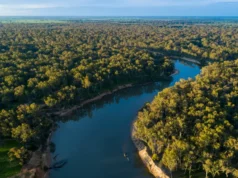
In the winter of 1895, a parish priest from the Austrian mountain village of Warth received in the post a rather cumbersome package from a clerical colleague in Scandinavia. It was a pair of thin, wooden planks, measuring over two metres in length and apparently designed to be strapped to the feet. The unexpected arrival aroused the interest of the local newspaper, who reported a slight issue with these newfangled snowshoes: “No one has the scantest idea of how to use them.”
From where I’m standing now, at the top of the Kapall chairlift, 2330m high in the place they call “the cradle of alpine skiing,” it’s safe to say the people of the Arlberg have got those planks figured out. So much of how we ski today, from the lessons we take, to the turns we learn, to the equipment we use, can be traced back here. Looking around, you must admit they had some pretty good material to work with.
An unbroken view of snow-covered Alps stretches to the horizon. Skiers plunge over the crest, carving exquisite lines 1000 vertical metres down a world cup course to the village of St. Anton; others lounge on deck chairs in the sun, sipping beer or eating strudel. A golden retriever trots past, leaving pawprints in the soft Spring snow. Could the scene be more European?
Geographically speaking the Arlberg is a massif. It’s also massive. Ski Arlberg resort boasts 88 lifts, 300km of groomed slopes, 250km of off-piste and 80km of cross country. A €45 million investment in four new lifts, including the 1.8km Flexenbahn cableway, has completed the missing link between the villages of St. Anton, St. Christoph, Stuben, Zürs, Zug, Lech, Schröcken and Warth, making this the largest inter-connected ski resort in Austria. It must have felt eery last season, when it was open only to locals. “We felt like sheikhs of the mountain,” our ski guide Yannick Rumler says. But even now at full capacity there’s so much space on the slopes, and barely a wait at the lifts.
The return to pre-pandemic revelry couldn’t be announced any more empathically than at the Mooserwirt in St. Anton, one of Europe’s most infamous aprés ski bars. At the slope-side entrance hundreds of skis and poles are strewn like debris from a storm surge. The music thumps and the terrace throbs as one technicolour organism, hundreds of skiers squished in a heaving, virus-taunting swarm of humanity, dancing on tables and pumping fists to the latest Euro-pop hits. After two years of being conditioned to social distancing, it’s like another planet. Oh, and did I mention I’m staying here?
Read the full story here


